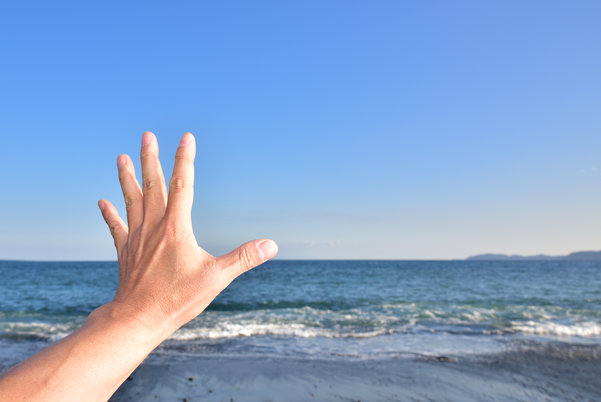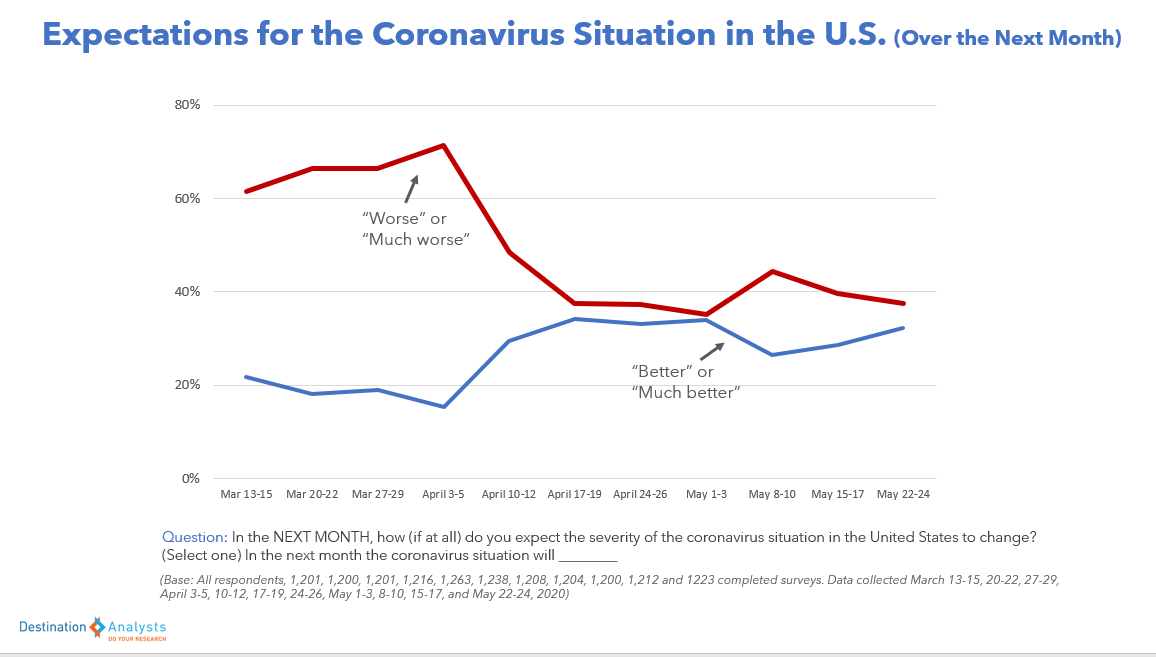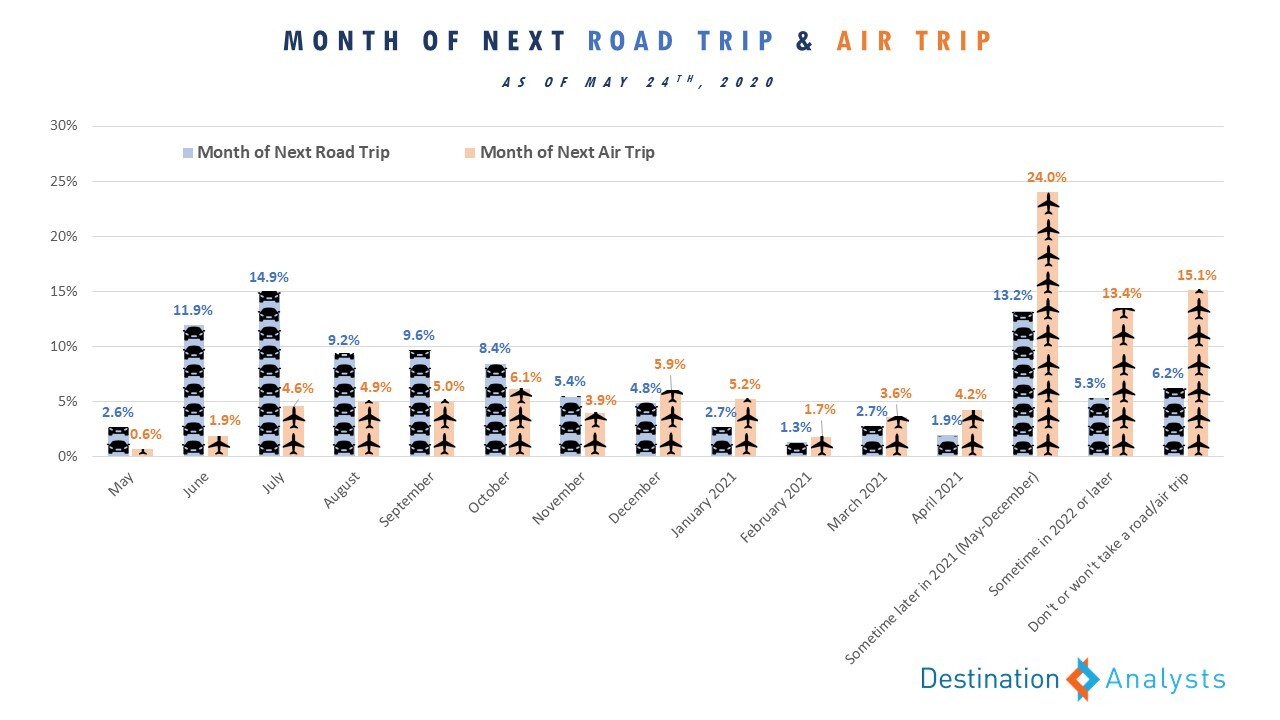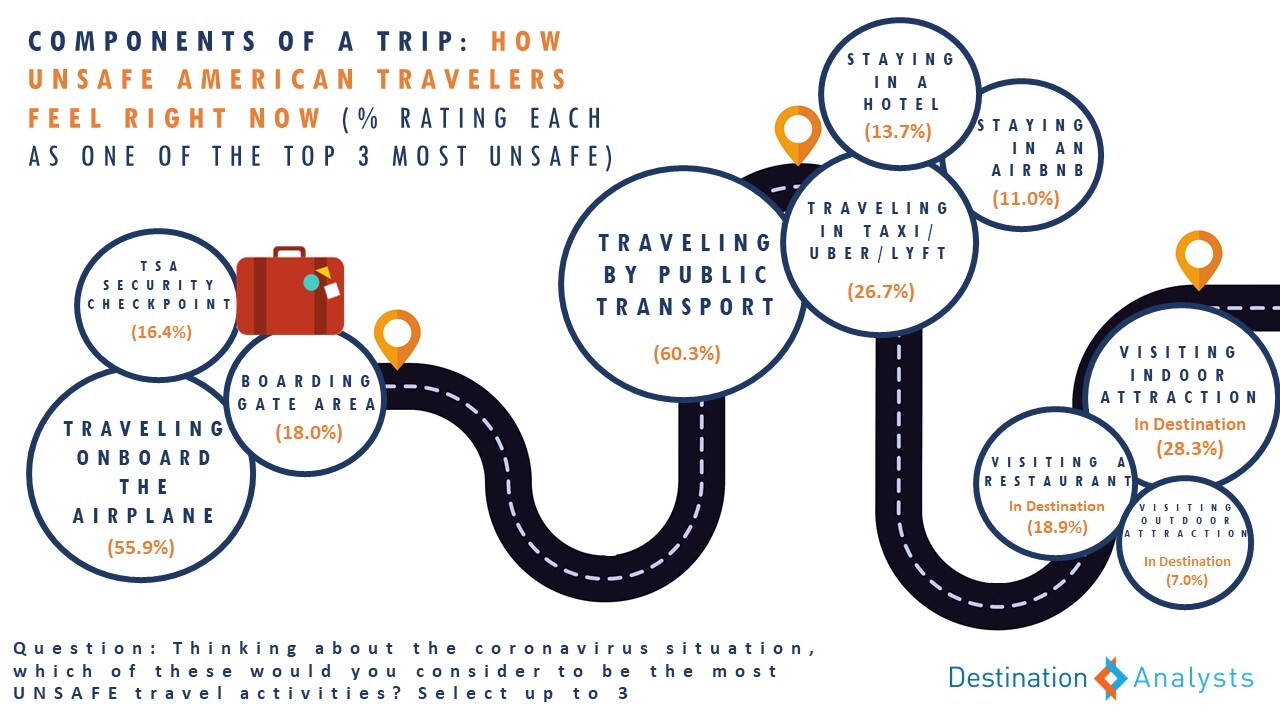Update on American Travel in the Period of Coronavirus—Week of May 25th
American travelers continue a slow march towards feeling safer, but the COVID-19 pandemic has wreaked havoc on the industry’s future—far worse than what was seen in the Great Recession.

IMPORTANT: These findings are brought to you from our independent research, which is not sponsored, conducted or influenced by any advertising or marketing agency. Every week since March 15th, Destination Analysts has surveyed 1,200+ American travelers about their thoughts, feelings, perceptions and behaviors surrounding travel in the wake of the coronavirus pandemic. The findings presented below represent data collected May 22nd-24th.
Key Findings to Know:
- American travelers continue a slow march towards feeling safer.
- The pandemic has wreaked havoc on the industry’s future, with significant declines in American travel intentions, spending and sentiments from January 2020—and worse than what was seen in the Great Recession.
- Air travel, non-private transportation and indoor attractions are seen as the least safe aspects of the common travel journey.
- A majority of travelers still do not yet feel that either a hotel or Airbnb/vacation home rental experience are safe right now.
- Only 5.9% reported taking a Memorial Day weekend trip.
- Younger travelers will very likely be key to many destinations’ and travel providers’ recovery.
American travelers continue their slow march towards feeling safer. This week brought another improvement in their concerns about personally contracting the virus (6.6/10), their friends or family contracting it (7.0/10, an 11-week low), the impact the virus has on their personal finances (6.4/10—near the level it was the week of March 15) and its impact on the national economy (7.8/10, the lowest its been since March 15). Perceptions of the safety of various travel activities are nearing what was recorded the week of March 15th when we began this measurement (and before the most dramatic drop in safety perceptions, which occurred between March 15 and 22nd). The proportion agreeing they are going to avoid all travel until the coronavirus situation is blown over in their mind is also near the level it was March 15th (61.1%). Opinion that the coronavirus situation will get better in the U.S. in the next month again increased from the dip seen the week of May 8th (32.3%).

However, these improvements remain gradual and incremental, and the travel industry still shows a long journey back to where it was. (Important Note: To see the profound impact the COVID-19 pandemic has wreaked on the travel industry, you can find a full summary comparing American travel intentions, spending and sentiments in January 2020 to this week of May 25th—as well as to the Great Recession and back to 2006—here) In addition to the significant drops in expected trip volume and spending on travel, this week the percent saying they will take a staycation rather than a vacation this summer (57.6%) and the percent saying they are going to wait until 2021 to travel again (32.6%) both reached a high.
Health and safety remain central to this measured outlook and behaviors toward travel, and this is profoundly seen in current perceptions of air travel. Over one-third of airline travelers still characterize traveling onboard an airplane as “very unsafe” (and another quarter say it is “somewhat unsafe”). While they show lesser concerns about the boarding gate/waiting areas and TSA security checkpoints, many Americans are looking to put off their next air trip until 2021 or later.

It’s imperative to the industry’s recovery that travelers feel they will be safe in every aspect of their journey, and certainly travel industry related businesses are working hard to ensure this is a reality. To examine where the strongest points of resistance may be and/or which experiences may need more safety guidelines communicated, we asked travelers to rate what they feel are the TOP THREE most unsafe components of a common travel experience. Right now, taking public transportation, traveling onboard the airplane, visiting indoor attractions in their trip destination, and traveling in taxis/Ubers/Lyfts are most agreed upon as the least safe aspects of a potential trip.

Although lodging was not as commonly chosen as the least safe aspect of a typical trip, it is important to understand the degree to which travelers are feeling they will be safe at Airbnbs/vacation home rentals (often perceived as easier to socially distance but without the formalized levels of housekeeping/sanitation) and hotels (often perceived as being more difficult to avoid other travelers but with the ability to enact strict sanitation protocols). Staying in a hotel is currently perceived as safe by 27.6% of American travelers and staying in an Airbnb/vacation home rental by 21.3%. Note that younger travelers are much more trusting of Airbnb/vacation home rental safety compared to older travelers.
With Memorial Day weekend traditionally considered the (un)official start of the summer travel season–and now the first national holiday celebrated during the COVID-19 pandemic, but with all 50 states under loosened restrictions, this made for an interesting study. Did Americans, in fact, travel? As of the morning of May 24th—the Sunday of Memorial Day weekend 2020—just 5.9% of American travelers reported they were taking a trip this holiday. Of those that went on a trip, 42.7% made the decision to take it within the last week. Similarly, a recent Harris Poll conducted about Memorial Day travel plans found that 95% of the American population believed it was too soon to travel. In addition, AAA declined to put out its annual Memorial Day travel estimate citing COVID-19’s impact on the accuracy of their data, but expected it to be a record low in their two decades of this forecast.

Younger travelers will very likely be key to many destinations’ and travel providers’ recovery. Last week we reported that Millennial travelers will be at the forefront of the industry’s recovery, due to their relatively higher sense of safety for themselves and travel activities, combined with the ability to motivate them to travel with discounts —things that we continue to see this week. Nearly 40 percent of Millennial travelers report they will make travel at least a somewhat high priority in their lifestyle—double the number of Baby Boomers who said the same—and plan to spend $3,000 on leisure travel in the next three months–$1,000 more than Baby Boomers report. They also plan to visit a more diverse set of destinations in the next year.


